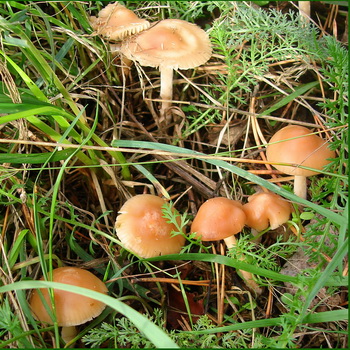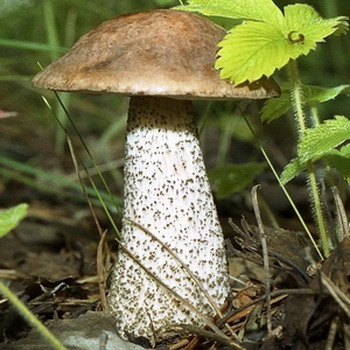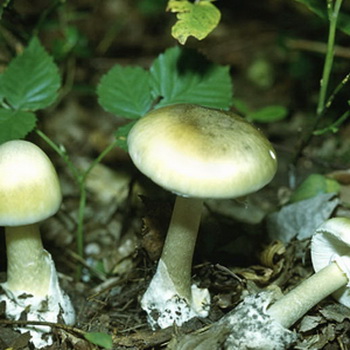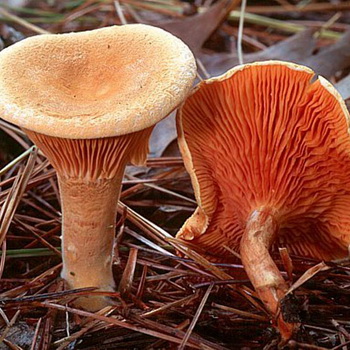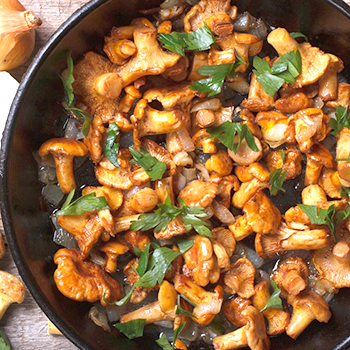Edible types of mushrooms: photos, names and descriptions of varieties of mushrooms (real, yellow, bitter, red-brown)
 All types of mushrooms always grow in groups, their name comes from the Church Slavonic "mushroom" (heap). And the caps of adult specimens of edible milk mushrooms often reach 20 cm in diameter. So, going on a "quiet hunt" for real white milk mushrooms, mushroom pickers rarely come empty-handed.
All types of mushrooms always grow in groups, their name comes from the Church Slavonic "mushroom" (heap). And the caps of adult specimens of edible milk mushrooms often reach 20 cm in diameter. So, going on a "quiet hunt" for real white milk mushrooms, mushroom pickers rarely come empty-handed.
Below you can see the photos and names of varieties of milk mushrooms and find out which edible milk mushrooms are best suited for pickling and pickling. You will also get an idea of what real milk mushrooms and other types of these edible mushrooms (yellow, bitter and red-brown) look like.
Photo and description of the yellow mushroom
Category: edible.
Other names: yellow load, yellow wave, scraped.
Translated from Latin, the name of the yellow milk means "rumpled".
Mushroom yellow lump (Lactarius scrobiculatus) has a cap 6-28 cm in diameter. Usually it is yellow, but it can be brown or slightly golden, often with small scales. In young mushrooms, it has a slightly convex shape, then gradually straightens or becomes concave. The edges are usually bent. Smooth to the touch, may be mucous in wet weather.


Pay attention to the photo of a yellow breast, its leg is 5-12 cm high with characteristic bright yellow pits or indentations, sticky and sticky, very strong, hollow.
Plates: frequent, in adult mushrooms, usually with brown spots.
Pulp: white, but turns yellow on the cut and when interacting with air, like thick milky juice. It has a weak but very pleasant fruity aroma.
According to the description, the yellow milk mushroom is very similar to fringed breast (Lactarius citriolens), purple (Lactarius repraesentaneus) and real (Lactarius resimus). Fringed breast milk differs from yellow in that it grows exclusively in deciduous forests and, like the real one, does not have dents on the leg. And the inedible purple breast has lilac-colored milky juice.
When it grows: from mid-July to early October in temperate countries of the Eurasian continent.


This type of mushroom can be found on the limestone soils of coniferous forests, less often next to birches.
Eating: Russian mushroom pickers consider it a very tasty mushroom, they use it after preliminary soaking and boiling.
Application in traditional medicine (data not confirmed and not passed clinical trials!): in the form of a decoction as a means of combating gallstone disease.
What a real mushroom looks like (white): photo and description
Category: edible.


Other names: white milk mushroom, raw milk mushroom, rightful milk mushroom, wet milk mushroom.
Since the beginning of the XIX century. in Russian scientific circles, the real milk mushroom was called pepper milk - Lactarius piperatus. But in 1942 the scientist-mycologist Boris Vasilkov proved that the people consider the species Lactarius resimus to be the real one.


Above you can see what the white lump looks like in the photo. Its cap (diameter 6-25 cm) is white or yellowish. In young mushrooms, it is flat, but over time it acquires the shape of a funnel. On the edges bent towards the inner side, there is almost always a noticeable fluff. It is sticky and very wet to the touch.


If you look closely at the photo of a real mushroom, you can almost always notice plant debris on its hat, which sticks to the mushroom more often than to other mushrooms.
Leg (height 3-9 cm): white or yellowish, cylindrical, hollow.


In the photo of a real weight, frequent plates of white or yellowish color are clearly visible.
Pulp: white with white milky juice, which, when exposed to air, becomes dirty yellow or grayish. The smell is similar to that of fresh fruit.
Doubles: white podgruzdok (Russula delica), the main difference of which is the absence of milky juice in the latter.The violin case (Lactarius vellereus) also looks like a white lump, only its hat is more "felt" and there is no cannon. White boll (Lactarius pubescens) is much smaller in weight and with a more pubescent cap. Aspen milk mushroom (Lactarius controversus) grows under aspen trees, where real milk mushrooms are practically not found. And the milky juice of peppercorns (Lactarius piperatus) turns green when it interacts with air.
The white mushroom grows from the beginning of July to the end of September in the Volga region, Siberia and the Urals.


Where can I find: in deciduous and mixed forests next to birches.
Eating: salted after long boiling to remove bitterness. Under the influence of brine, juicy and fleshy real milk mushrooms acquire a bluish tint, and after 40 days you can already enjoy their taste. In Siberia, traditionally, real milk mushrooms are salted along with volushki and mushrooms. During the famous meal, arranged in 1699 by the Archbishop of Moscow and All Russia Andrian, guests were served, in addition to other dishes, “three long pies with mushrooms, two pies with milk mushrooms, cold mushrooms with horseradish, cold milk mushrooms with butter, milk mushrooms heated with juice, yes oil ... ". In Western Europe, a real mushroom is considered an inedible mushroom, and in Russia it has long been called the king of mushrooms. A real milk mushroom surpasses even fatty meat in calorie content: in dry matter, the protein content reaches 35%.
Application in traditional medicine (data not confirmed and not passed clinical trials!): in the treatment of renal failure and urolithiasis.
What edible types of milk mushrooms are suitable for salting: bitter milk mushroom
Category: edible.


Above is a photo of what it looks like bitter lump (Lactarius rufus)... Its cap with a diameter of 3-12 cm, usually brown or reddish, has the shape of a bell, over time it becomes noticeably straightened, a small cone-shaped tubercle appears in the center. In mature mushrooms, it is depressed. Smooth to the touch, with slight pubescence, after rain or in damp weather it can be sticky and slippery. The edges, as a rule, are strongly curved towards the inner side and lighter than the center.
Leg (height 3-9 cm): relatively thin, cylindrical in shape, similar in color to the cap. It is covered with light down and has a noticeable thickening at the base.
Plates: frequent and narrow.
Pulp: very brittle, gives off a thick, whitish milky juice on the cut. It does not emit practically any smell, and the mushroom got its name for its peppery bitter taste.


According to the photo and description, this type of milk mushrooms looks like inedible hepatic lactate (Lactarius hepaticus), the milky juice of which turns noticeably yellow in air; edible camphor lactarius (Lactarius camphoratus), which has a characteristic camphor odor, and marsh milkman (Lactarius sphagnei)growing only in swampy areas.
When it grows: from mid-July to the end of September in almost all countries of the northern half of Europe and Asia.
Where can I find: on acidic soils of coniferous forests, less often in dense birch forests.
Bitter milk is suitable only for salting, and only after thorough soaking with a constant change of water (10-12 hours). This is done to remove bitterness. When interacting with brine, this type of edible milk mushroom darkens noticeably.
Application in traditional medicine: does not apply. However, scientists have learned to isolate from the bitter milkweed a substance that inhibits the growth of Staphylococcus aureus bacteria, hay and Escherichia coli.
Important! Bitter mushrooms can accumulate the radioactive nuclide cesium-137, which is deposited in the liver and muscles of humans and animals, so you should not collect this mushroom in areas of radioactive contamination.
Other names: bitter, red bitter, mountain goat. Mushroom pickers call the bitter mushroom a traveler, as it is often found during the "quiet hunt".
What does a red-brown mushroom look like (Lactarius volemus)
Category: edible.
Edible red-brown milk mushrooms have rather large caps - up to 18 cm in diameter (matte, light brown, less often with a red or bright orange tint).In young mushrooms, it is rounded, but over time it becomes prostrate, and then depressed.


As you can see in the photo of edible mushrooms, the edges of the caps are often bent towards the inside. It is usually dry and smooth to the touch, but can be covered with a network of small cracks, and in wet weather it can be slimy or sticky.
Leg (height 3-12 cm): velvety, strong and thick, cylindrical in shape. The color usually does not differ from the cap.
Plates: narrow and frequent, slightly pinkish or yellow, but more often white. When pressed, brown spots form on the surface.


Pay attention to the photo of this variety of milk mushrooms: the flesh of the mushroom is very brittle, white or reddish in color. It tastes sweet. Freshly cut mushroom smells like herring or boiled crabs.
Doubles: the milky is not caustic (Lactarius mitissimus), but the skin on its cap does not crack, and the mushroom itself is much smaller.
When it grows: from early August to mid-October in almost all European countries.
The red-brown type of mushroom mushrooms can be found in different forests next to all kinds of trees. Prefers damp, dark places.
The red-brown lump is found even at an altitude of 1000 m above sea level.
Eating: very tasty salted and fried.
Application in traditional medicine: does not apply.
Other names: poddubenok, smooth, leaflet, euphorbia, milkweed.






